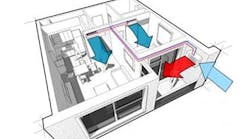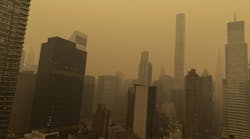When a customer calls Kahn Mechanical Contractors with questions or concerns about the indoor air quality (IAQ) in his or her building, we have our service technicians check a number of items.
Much like solving a mystery, following a logical course of investigation will enable you to “crack the case” and solve the customer's IAQ issues.
The first thing to consider is the overall environment of the building. Are there any chemicals involved? Is it a high-traffic, high-occupancy situation? Look at the big picture first to understand what factors are playing into the building's IAQ.
For example, we receive many complaints during or just after a remodel. New carpeting, paint, even new furniture can affect IAQ, and there are times that we need to make an adjustment for more outside air to be introduced in order to get odors from these materials to dissipate.
Our technicians check several items as they're changing filters.
First, they check the evaporator coil for any build-up of dust or dirt. A dirty evaporator coil can cause several problems: the coil will not work properly, causing the unit to freeze up, or the coil will not take out the moisture in the air as it should, causing the building to feel damp.
Second, they check to make sure the drain pan is in proper condition. We want no leaks or overflow from drain pans, as this can cause unwanted moisture to be introduced to the unit cabinet and duct work. Things start to grow — and sometimes smell — if moisture is present.
Our technicians also check the outside air portion of the unit. If the unit has a manual outside air damper; we check and clean this filter. If the unit has an economizer, we check to ensure that it's working properly.
Air balance is another important consideration. Many buildings have separate make up air units along with exhaust fans. These must be checked and maintained for proper IAQ. If a building doesn't have enough outdoor air, it may seem stuffy or stagnant. Too much makeup air, on the other hand, wastes energy and causes a positive pressure, which can force conditioned air to the outside of the building.
If there's a kitchen involved, the exhaust fan and makeup air unit must be properly balanced as well (see Comfort Food from August 2009 issue). Too much exhaust, and you're exhausting excess conditioned air out of the building. Too much makeup air, and you're introducing too much untreated air, and putting excessive load on the equipment, and spending unnecessary energy dollars. Many times, the makeup air filter is ignored or completely missing. This has to be corrected, as it's filtering the outside air introduced into the hood.
Our technicians also pay close attention to unit penetrations. We want no water intrusion into the building envelope, as this could cause biological growths.
The steps service technicians can take to help ensure good indoor air quality in commercial buildings are basically pretty simple and straightforward, but they can pay off for your customers in a big way.
Dennis Brisbon is the service manager at Kahn Mechanical Contractors, Inc, Dallas, TX. The company was ContractingBusiness.com's 2008 Commercial Contractor of the Year. Brisbon can be reached at 214/631-1010, or by e-mail at [email protected].








